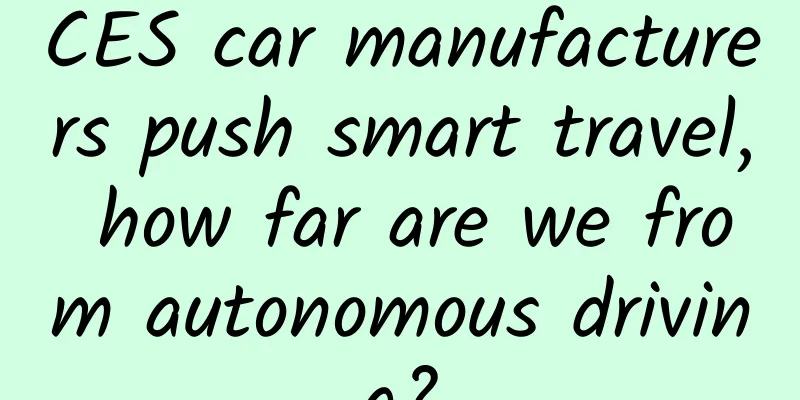CES car manufacturers push smart travel, how far are we from autonomous driving?

|
Smart transportation is undoubtedly one of the hottest areas at this year's International Consumer Electronics Show (CES ). The entire North Hall of the Las Vegas Convention Center is basically completely occupied by automobile manufacturers, suppliers or technology companies related to smart transportation. Outside the venue, there is also a large area for manufacturers to experience driverless testing. These manufacturers who came to the CES venue are actually helping the industry to reshape the concept of "cars", making people feel that, like color TVs, refrigerators, and mobile phones, cars have become more and more popular consumer goods in people's daily lives. Along with this process, the car as a means of transportation has been fully upgraded to be intelligent. This process may be somewhat similar to the process of mobile phones transitioning from feature phones to smartphones that we have experienced before. That is, cars are no longer "cold" and have become more "understanding" of people, thus providing a more comfortable travel experience. Through demonstrations of driverless driving, in-vehicle intelligent systems, vehicle networking, maps, etc., many manufacturers during the CES exhibition painted a picture of their understanding of future intelligent transportation to the outside world. However, under the vision collectively promoted by major manufacturers, it is easy for people to have the illusion that "the future has arrived", but in fact, there are still many problems and obstacles in the field of smart travel that need to be overcome, whether it is at the technical level, or at the regulatory and legal level, as well as the acceptance and awareness of the terminal market. All of the above determine that people's future travel will definitely become smarter, but this will still be a gradual process. Manufacturers convey their intelligent ideas about future travel Autonomous driving and driverless driving are becoming hot words at the 2017 International Consumer Electronics Show (CES). But in fact, in addition to driverless driving, both technology companies and traditional car manufacturers (OEMs and suppliers) actually want to convey a broader concept, which is their understanding of future mobile travel life. Generally speaking, these manufacturers have many similarities in their visions for future travel life, which can be summarized into intelligent, networked and shared travel. First of all, intelligence includes many connotations, and driverless driving is one of them. The purpose of intelligence is to make the "cold car" "alive" in the future. Specifically, no matter it is driving on the road or stationary, it can perceive the surrounding environment and the passengers in the car and make corresponding decision responses. As far as driverless technology is concerned, the industry as a whole is currently still in the transition stage from L2 to L3 autonomous driving levels. Some manufacturers have made major breakthroughs in L4, but are still a long way from L5. Gill Pratt, CEO of Toyota Research, said during CES that fully autonomous driving is "not even close" at present. He said that the ultimate realization of fully autonomous driving is a very beautiful goal, but both the automotive industry and the technology industry are still a long way from achieving Level 5 autonomous driving. At this year's CES, many manufacturers brought autonomous driving demonstrations. In the open space outside the main venue, attendees can personally experience the latest developments in autonomous driving technology from these manufacturers. However, it should be emphasized that these demonstrations are all conducted in a closed environment, with complete route map data, and technicians working in the car sitting in the driver's seat to take over the driving of the vehicle at any time. In other words, all of these autonomous driving demonstrations are Level 3. In terms of specific technologies, autonomous driving is mainly divided into three parts: perception, decision-making and control. Perception mainly involves real-time collection of road data through lidar, cameras, etc., decision-making involves real-time data analysis through in-car computers, and control involves real-time adjustments to vehicle driving based on these data. Technology companies (including hardware and software companies) have certain advantages in perception and decision-making, while traditional automakers have rich experience in control. In addition, maps and car connectivity are also particularly important. Therefore, technology companies and traditional automakers believe that leveraging their respective strengths will maximize profits, so cooperation between them has become a natural result. At this CES, we saw that some of these collaborations are happening, and some have even achieved initial results. For example, the cooperation plan between BMW, Intel and Mobileye will have 40 vehicles for driverless testing in the second half of this year, and BAIC and Baidu announced cooperation and said they will conduct road tests before the end of this year. Already happening, such as the cooperation between Google Waymo and Chrysler, and the cooperation between Uber and Ford, have already conducted a large number of driverless tests. Another important aspect of intelligence is the intelligence of the relationship between cars and people. In the past, people only treated cars as machines to complete travel, but in the future, the relationship between cars and people will become closer and closer, and cars will "understand" people more and more. At this CES, many manufacturers have proposed the intelligence of voice interaction between people and cars and the personalization derived from it. For example, Toyota released a concept car called "Love i" at this CES, which has a built-in artificial intelligence assistant called "Yui". Toyota hopes that this assistant can bring more friendly experience to passengers in the car. The assistant can detect the physical characteristics and real-time health status of passengers in real time and can respond to voice commands. Similarly, Nissan and BMW cooperated with Microsoft to incorporate Microsoft's Cortana voice assistant into the in-car system, which is also an innovation in the future human-computer interaction method. (BMW and Nissan incorporate Microsoft Cortana smart voice assistant into their car systems) Whether it is autonomous driving or in-vehicle intelligent systems, a large amount of data needs to be processed in real time, which requires that every car on the road in the future is a powerful "supercomputer". At this CES, as a keynote speaker, Nvidia founder Huang Renxun announced the new generation of supercomputer chip solutions for automobiles, Xavier, which uses an 8-core ARM architecture CPU and a 512-core GPU. The cooperation between Nvidia and Audi has also been implemented, and an unmanned driving demonstration was carried out during the exhibition. (Nvidia and Audi's collaborative test vehicle demonstrated autonomous driving experience during CES) In the future, intelligent transportation requires not only that each vehicle itself becomes more intelligent, but also that vehicles on the road can be connected in real time and with terminal control to form real-time information sharing, thereby improving overall traffic efficiency. Therefore, data transmission is also a key link in future intelligent transportation. At this year's CES, Intel launched a 5G-based modem chip that can be used in mobile devices such as cars. Intel CEO Brian Krzanich said that by 2020, the amount of data generated by each smart car every day will be around 4,000G. Such a large amount of data also requires vehicles to be able to process in real time during the dynamic process of driving. In addition, wireless operator AT&T has currently conducted 5G network-based tests in a travel test site established in Michigan, the home of the American Motor City, mainly focusing on the connectivity of future cars. (AT&T conducts high-speed mobile wireless transmission tests at a test site) In the future, when cars are intelligent, connected and shared, the current traditional car business model may also undergo disruptive changes. In the future, people may no longer need to actually own a car, but instead obtain timely and customized travel services under various demand scenarios through subscription services. These possible future business model change scenarios have been foreseen by many manufacturers. For example, Cadillac proposed a monthly vehicle subscription service of US$1,500 at this CES. The car models cover almost all models under the Cadillac brand. Users can choose any vehicle according to their own needs. This model may be the prototype of future travel services. How far are we from autonomous driving? At this year's CES, seeing so many manufacturers focusing on the fields of driverless driving and smart travel, it is easy to have the illusion that autonomous driving is very close to us. But in fact, the real implementation of driverless driving at the user and consumer level, at least for now, is still very far away from us. First of all, there are still many obstacles to overcome on the technical level. At this CES, the driverless experience demonstrated by many manufacturers makes people feel that the current autonomous driving technology is very mature and can be put on the road in minutes. But in fact, the "driverless" demonstrated and the real driverless are still far away. These driverless experiences have many prerequisites and restrictions. For example, they are all carried out in a closed environment without any other road interference, the route has been planned, and there are technical staff in the car to take over the vehicle control at any time. In addition, the current driverless driving has high requirements for weather conditions. In extreme weather such as rain, fog, ice and snow, the current driverless technology solutions are basically completely ineffective. In addition, the deep learning solutions proposed by many manufacturers for perception and recognition are still in the early stages, and the problem of how to process large amounts of data in a short period of time and the accuracy of recognition still needs to be solved in the future. Secondly, even when the technology is fully mature, driverless cars will still face a series of regulatory challenges before they can be put on the road. In the United States, although various regions are relatively open to driverless testing, regulators are still very cautious. Not long ago, when Uber was conducting a public road test of driverless cars in San Francisco, California, it was stopped by the local traffic management department for running a red light and had to move to other areas for testing. Any accident caused by driverless cars will cause new doubts from the outside world. Pratt pointed out that people's tolerance for driverless cars is actually very low. Even if the data shows that driverless cars can reduce the fatality rate of traffic accidents by half, people will still have reservations about this technology. Finally, it comes down to the specific user and consumer level. Although they are curious and expectant about autonomous driving and driverless driving, at least most people are still cautious and wait-and-see about this new technology. Tencent Technology randomly interviewed some participants at the CES site. Most of them believed that they are willing to experience driverless driving, but when driving on the road now, they still trust their own control and judgment. After all, this technology is not mature enough. The above factors determine that it will still take a long time for driverless cars to be finally realized. A more realistic approach is a step-by-step approach, which is also proposed by many manufacturers. First, driverless cars are promoted on fixed routes or closed places, such as vehicle traffic within the park, long-distance freight, etc., as well as lanes specially opened for driverless vehicles, which are separated from normal driving vehicles and do not interfere with each other, and finally gradually extended to driverless cars on all road conditions. Therefore, intelligent travel will eventually be realized, but this process may not be completed quickly. It will be more realistic to achieve it in a step-by-step manner. As a winner of Toutiao's Qingyun Plan and Baijiahao's Bai+ Plan, the 2019 Baidu Digital Author of the Year, the Baijiahao's Most Popular Author in the Technology Field, the 2019 Sogou Technology and Culture Author, and the 2021 Baijiahao Quarterly Influential Creator, he has won many awards, including the 2013 Sohu Best Industry Media Person, the 2015 China New Media Entrepreneurship Competition Beijing Third Place, the 2015 Guangmang Experience Award, the 2015 China New Media Entrepreneurship Competition Finals Third Place, and the 2018 Baidu Dynamic Annual Powerful Celebrity. |
>>: Audi Dealer Association to be established, SAIC-Audi joint venture final negotiations to start
Recommend
Direct-sale e-commerce market trends and product intelligence in May
Which categories are hot-selling in various chann...
Planting grass! Can reclaiming saline-alkali land and planting forage grass protect the ecology?
Salinization is known as a stubborn disease of th...
To promote Internet products, are you still using traditional branding methods?
As we all know, the advertising industry has a hi...
I wanted to see clouds in the lab, but ended up changing history? That's physics!
When you look up at the clouds, do you know that ...
iOS 8 intimate little feature: view detailed battery usage
Some developers have used the iOS 8 beta and found...
Unbelievable! "Einstein's Brain" sold online for over 70,000. Who is buying it?
The world is so big that nothing is impossible. E...
Scientists say they can cool the earth by blocking sunlight. Is this true?
It has become an indisputable fact that the incre...
Can body temperature generate electricity? Chinese scientists achieve material breakthrough!
Recently, the team of Professor Zhang Qian and Pr...
Analysis of user operation strategies in internet celebrity live broadcast rooms!
How to get the audience to support you? To put it...
CES2015: The curved G3 is here! LG releases the Flex 2 phone
In the early morning of January 6, LG released it...
They were in their prime that year... Salute to their youth!
Be determined to serve the country and write a st...
If you don’t choose the right method, no matter how much advertising money you spend, it will be wasted!
If you want to sell your product well, you have t...
"Happy Candy Crush" APP Operation Analysis
Happy Match 3 is a strategy game developed by Ten...
A complete event operation design!
The theme of today's article is related to op...
Watch the sky and the sun, explore the sea of stars - Thousand-Eyed Dzi Beads "stare" at the sun, moon and stars →
On September 27, the Circular Array Solar Radio I...









